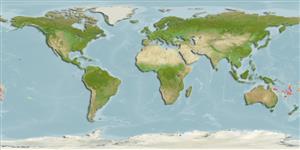>
Perciformes/Scorpaenoidei (Scorpionfishes) >
Triglidae (Searobins) > Pterygotriglinae
Etymology: Pterygotrigla: Greek, pterigion, diminutive of pteryx = wing, fin + Greek, trigla, es = red mullet (Ref. 45335); robertsi: Named for Clive Roberts..
Environment: milieu / climate zone / depth range / distribution range
Ecologia
marino batidemersale; distribuzione batimetrica 420 - 511 m (Ref. 95016). Deep-water
Western Pacific: endemic to the Coral Sea.
Size / Peso / Age
Maturity: Lm ? range ? - ? cm
Max length : 30.7 cm SL maschio/sesso non determinato; (Ref. 95016)
Short description
Chiavi di identificazione | Morfologia | Morfometria
Spine dorsali (totale) : 8; Raggi dorsali molli (totale) : 12; Raggi anali molli: 12. This species is distinguished by the following characters: presence of buckler in advance of D1 fin; no antrorse AIO spine; short anterior AIO spines (7-10% SL); long pectoral fin (47-55% SL), its first free ray long (33% SL); eye moderate (10-11% SL); long snout (16-20% SL), nape and breast scaleless; belly with scales; 9-12 short gill rakers (2%SL); dark pigment on dorsum of holotype (Ref. 95016).
Life cycle and mating behavior
Maturities | Riproduzione | Spawnings | Egg(s) | Fecundities | Larve
Richards, W.J. and T. Yato, 2014. Revision of the subgenus Parapterygotrigla (Pisces: Triglidae: Pterygotrigla). Zootaxa 3768(1):23-42. (Ref. 95016)
IUCN Red List Status (Ref. 130435)
Threat to humans
Harmless
Human uses
Strumenti
Special reports
Download XML
Fonti Internet
Estimates based on models
Preferred temperature (Ref.
123201): 2.9 - 5, mean 3.7 °C (based on 120 cells).
Phylogenetic diversity index (Ref.
82804): PD
50 = 0.5000 [Uniqueness, from 0.5 = low to 2.0 = high].
Bayesian length-weight: a=0.01259 (0.00515 - 0.03077), b=3.01 (2.79 - 3.23), in cm total length, based on LWR estimates for this (Sub)family-body shape (Ref.
93245).
Trophic level (Ref.
69278): 3.7 ±0.6 se; based on size and trophs of closest relatives
Resilienza (Ref.
120179): Medio, tempo minimo di raddoppiamento della popolazione 1.4 - 4.4 anni (Assuming tmax>3).
Fishing Vulnerability (Ref.
59153): Low to moderate vulnerability (27 of 100).
